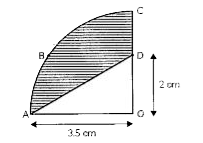The shaded region in the given figure is

A∩(B∪C)
A∪(B∩C)
A∩(B−C)
A−(B∪C)
The correct Answer is:D
The Shaded region in the figure is clearly A−(B∪C)
Topper's Solved these Questions
- SET THEORY AND REAL NUMBER SYSTEM Book:CENGAGEChapter:SET THEORY AND REAL NUMBER SYSTEM Exercise:Archieves
Explore 1 Video
- SET THEORY AND REAL NUMBER SYSTEM Book:CENGAGEChapter:SET THEORY AND REAL NUMBER SYSTEM Exercise:Exercise 1.5
Explore 12 Videos
- SEQUENCE AND SERIESBook:CENGAGEChapter:SEQUENCE AND SERIESExercise:Question Bank
Explore 36 Videos
- SETS AND RELATIONSBook:CENGAGEChapter:SETS AND RELATIONSExercise:Question Bank
Explore 15 Videos
Similar Questions
Find the area of the shaded region in the given figures (All measurements are in metre)
View SolutionFind the area of the shaded region in the given figure, if PQ = 24 cm, PR = 7 cm and O is the centre of the circle.

View SolutionFind the area of the shaded region in the given figure, if ABCD is a square of side 14 cm and APD and BPC are semicircles.

View SolutionFind the area of the shaded region in the given figure, if ABCD is a rectangle with sides 8 cm and 6 cm and O is the centre of the circle.

View SolutionFind the area of the shaded region in the given figure, if BC = BD = 8 cm, AC = AD = 15 cm and O is the centre of the circle.

View SolutionThe boundary of the shaded region in the given figure consists of three semicircular areas, the smaller ones being equal. If the diameter of the larger one is 14 cm, calculate
(i) the length of the boundary
(ii) the area of the shaded region
View SolutionWhich inequations represent the shaded region in the given figure
View SolutionThe area of shaded region in the given figure is

View SolutionFind the area of the shaded region in the given figure.
View SolutionFind the area of the shaded region in the given figure.

View Solution

